#Dragon Boat Festival/端午节
Text
[Hanfu · 漢服]Chinese Warring States period(475–221 BC) Traditional Clothing Hanfu-Life of Qu Yuan(屈原)
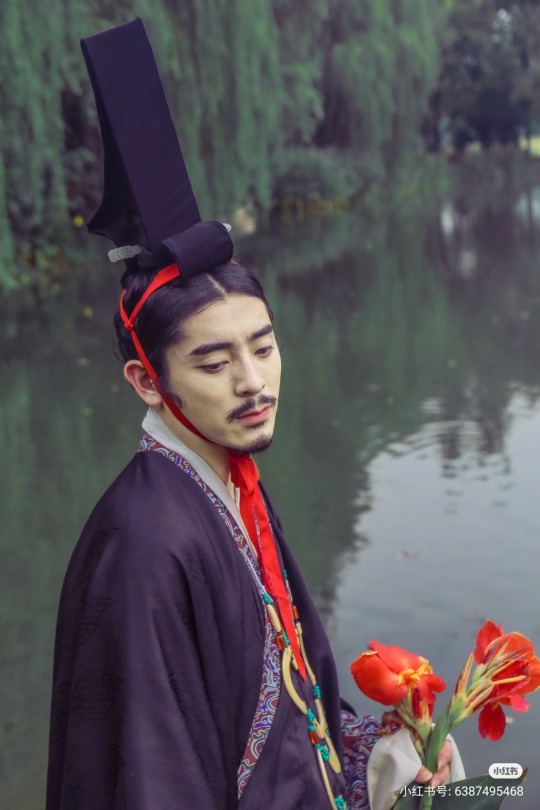
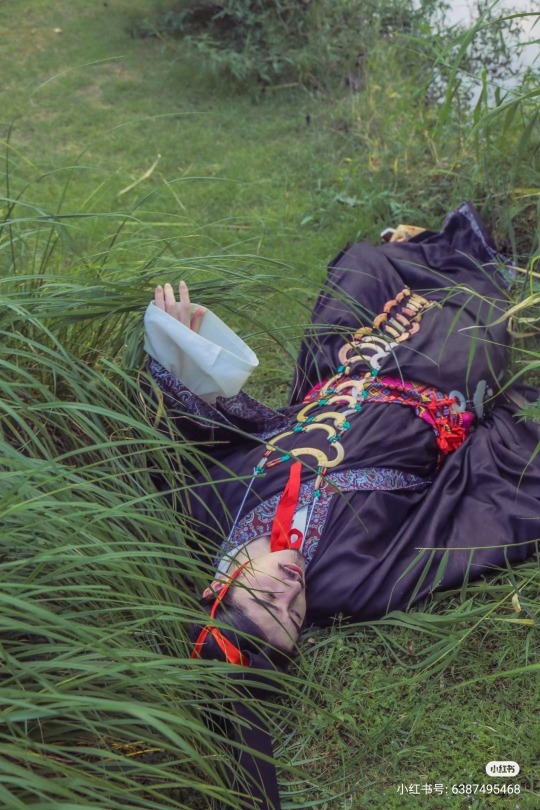
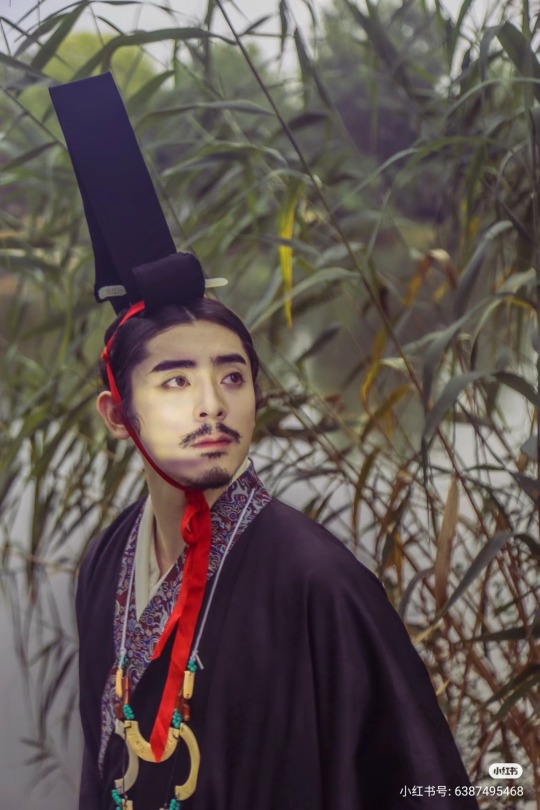

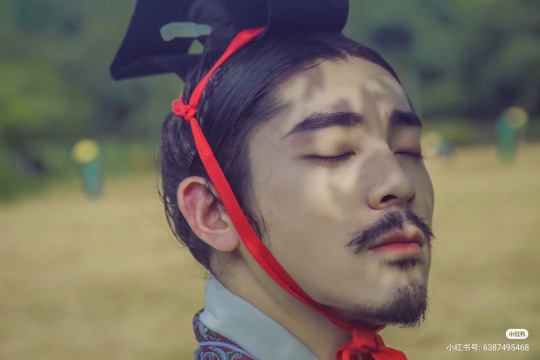
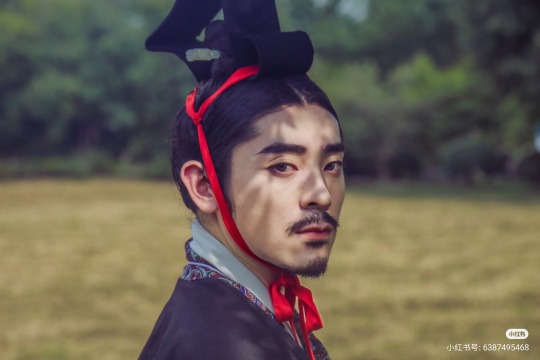
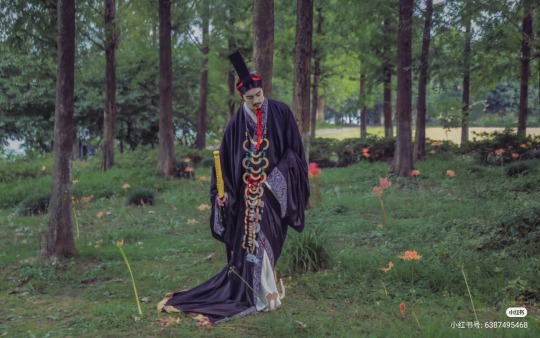
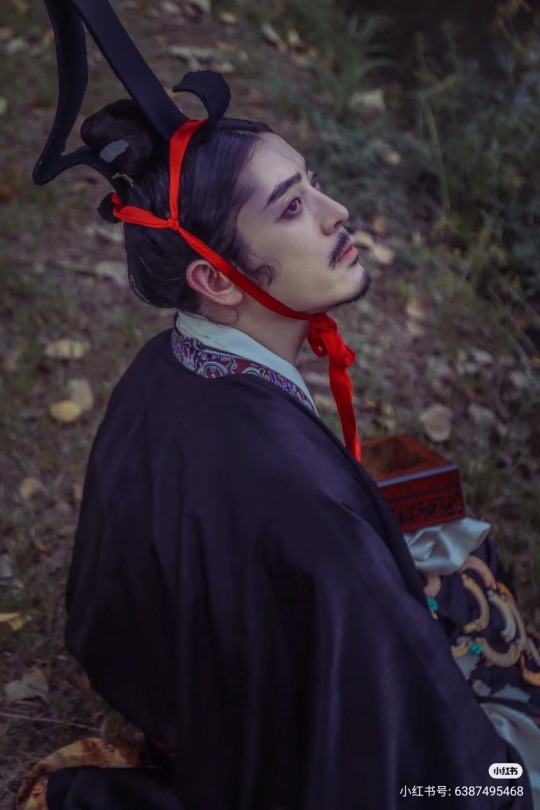
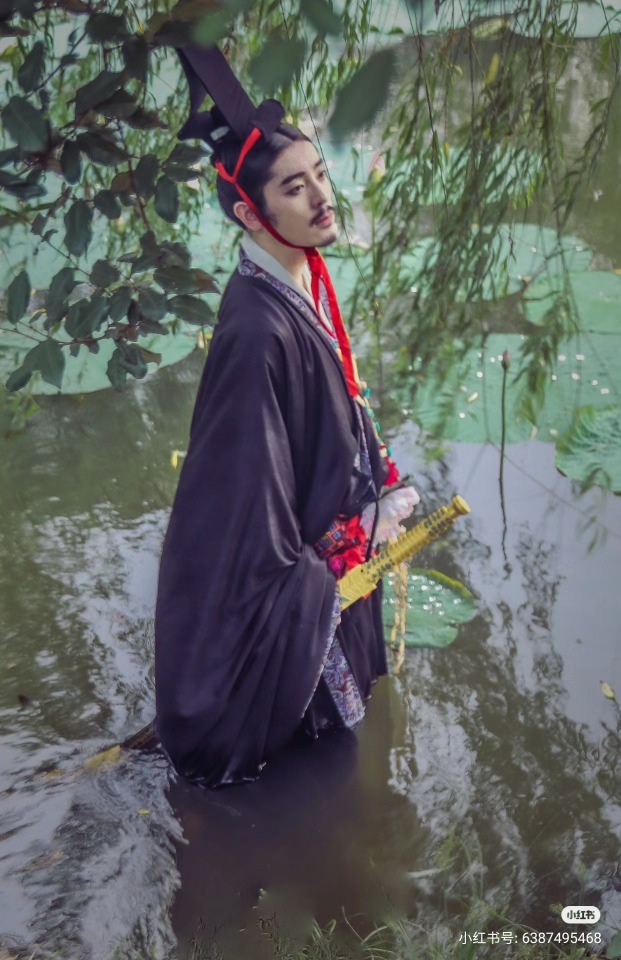
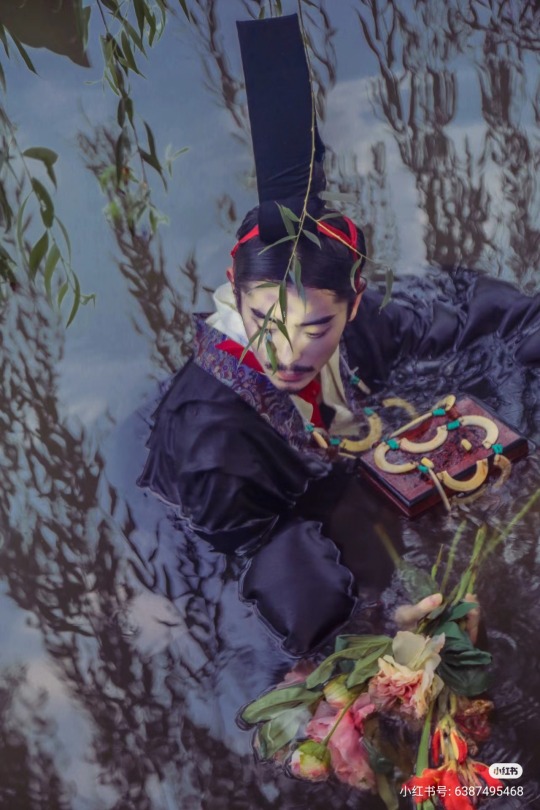
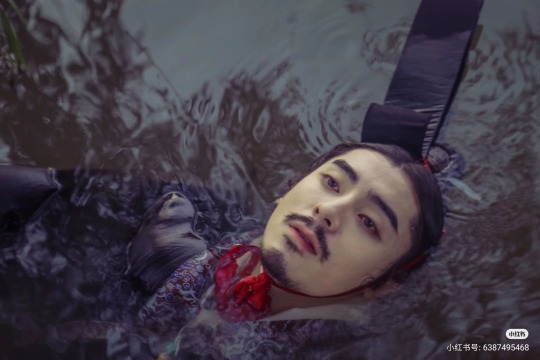
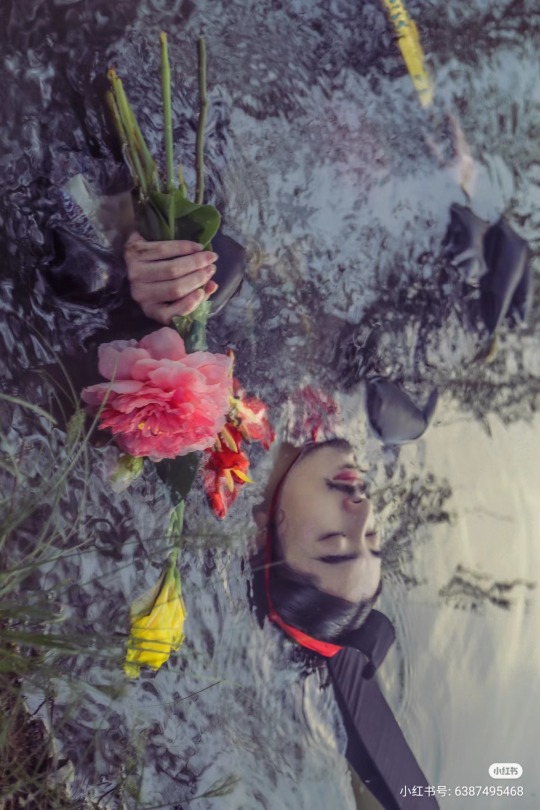

【Historical Artifact Reference】:
China Warring States period (475-221 BC):Silk painting depicting a man riding a dragon (人物御龍帛畫)
it was discovered in the Zidanku Tomb no. 1 in Changsha, Hunan Province in 1973. Now in the Hunan Museum
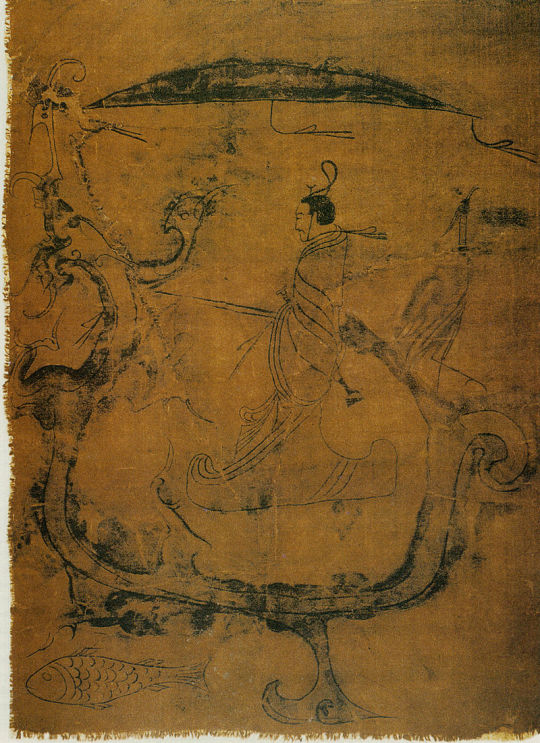
A man with a sword is riding a dragon by holding the rein. The dragon's body was given the shape of a boat. A little egret is standing at the tail of the dragon. A carp under the dragon is leading the way. The umbrella in the top middle of the picture shows the owner's nobility. The work has become associated with the Chu poet Qu Yuan’s famous verse from his poem Shejiang (涉江, Setting foot in the river), ‘Carrying a long sword with weird colour; Wearing a qieyun–styled high cap.” (帶長鋏之陸離兮, 冠切雲之崔嵬)
Western Zhou Dynasty seven-huang jade pendant with linked beads/西周七璜联珠组玉佩

About Qu Yuan(屈原)
Qu Yuan (c. 340 BC – 278 BC)was a Chinese poet and aristocrat in the State of Chu during the Warring States period. He is known for his patriotism and contributions to classical poetry and verses, especially through the poems of the Chu Ci anthology (also known as The Songs of the South or Songs of Chu): a volume of poems attributed to or considered to be inspired by his verse writing. Together with the Shi Jing, the Chu Ci is one of the two greatest collections of ancient Chinese verse. He is also remembered in connection to the supposed origin of the Dragon Boat Festival.
Historical details about Qu Yuan's life are few, and his authorship of many Chu Ci poems has been questioned at length.[4] However, he is widely accepted to have written "The Lament," a Chu Ci poem. The first known reference to Qu Yuan appears in a poem written in 174 BC by Jia Yi, an official from Luoyang who was slandered by jealous officials and banished to Changsha by Emperor Wen of Han. While traveling, he wrote a poem describing the similar fate of a previous "Qu Yuan."Eighty years later, the first known biography of Qu Yuan's life appeared in Han dynasty historian Sima Qian's Records of the Grand Historian, though it contains a number of contradictory details.
Life of Qu Yuan(屈原)
The only surviving source of information on Qu Yuan's life is Sima Qian's biography of him in Records of the Grand Historian (Shiji), although the biography is circumstantial and probably influenced greatly by Sima's own identification with Qu.Sima wrote that Qu was a member of the Chu royal clan and served as an official under King Huai of Chu (reigned 328–299 BC).
During the early days of King Huai's reign, Qu Yuan was serving the State of Chu as its Left Minister. However, King Huai exiled Qu Yuan to the region north of the Han River, because corrupt ministers slandered him and influenced the king.Eventually, Qu Yuan was reinstated and sent on a diplomatic mission to the State of Qi. He tried to resume relations between Chu and Qi, which King Huai had broken under the false pretense of King Hui of Qin to cede territory near Shangyu.
During King Qingxiang's reign, Prime Minister Zilan slandered Qu Yuan.[9] This caused Qu Yuan's exile to the regions south of the Yangtze River. It is said that Qu Yuan returned first to his home town. In his exile, he spent much of this time collecting legends and rearranging folk odes while traveling the countryside. Furthermore, he wrote some of the greatest poetry in Chinese literature and expressed deep concerns about his state. According to legend, his anxiety brought him to an increasingly troubled state of health. During his depression, he would often take walks near a certain well to look upon his thin and gaunt reflection in the water. This well became known as the "Face Reflection Well." On a hillside in Xiangluping (at present-day Zigui County, Hubei Province), there is a well that is considered to be the original well from the time of Qu Yuan.
In 278 BC, learning of the capture of his country's capital, Ying, by General Bai Qi of the state of Qin, Qu Yuan is said to have collected folktales and written the lengthy poem of lamentation called "Lament for Ying". Eventually, he committed suicide by wading into the Miluo River in today's Hunan Province while holding a rock. The reason why he took his life remained controversial and was argued by Chinese scholars for centuries. Typical explanations including martyrdom for his deeply beloved but falling motherland, which was suggested by the philosopher Zhu Xi of the Song dynasty, or feeling extreme despair to the situation of the politics in Chu while his lifelong political dream would never be realized. But according to "Yu Fu," widely considered to be written by Qu himself or at least, a person who was very familiar with Qu, his suicide was an ultimate way to protect his innocence and life principles.[citation needed]
Qu Yuan is said to have expressed his love for the ruling monarch, King Huai of Chu, through several of this works, including "The Lament" and "Longing for Beauty".
Dragon Boat Festival/端午节
Popular legend has it that villagers carried their dumplings and boats to the middle of the river and desperately tried to save Qu Yuan after he immersed himself in the Miluo but were too late to do so. However, in order to keep fish and evil spirits away from his body, they beat drums and splashed the water with their paddles, and they also threw rice into the water both as a food offering to Qu Yuan's spirit and also to distract the fish away from his body. However, the legend continues, that late one night, the spirit of Qu Yuan appeared before his friends and told them that he died because he had taken himself under the river. Then, he asked his friends to wrap their rice into three-cornered silk packages to ward off the dragon.
These packages became a traditional food known as zongzi, although the lumps of rice are now wrapped in leaves instead of silk. The act of racing to search for his body in boats gradually became the cultural tradition of dragon boat racing, held on the anniversary of his death every year. Today, people still eat zongzi and participate in dragon boat races to commemorate Qu Yuan's sacrifice on the fifth day of the fifth month of the traditional lunisolar Chinese calendar.
--------
Recreation Work by : @晴南
Xiaohongshu🔗:http://xhslink.com/CU2x9J
--------
#chinese hanfu#Warring States period(475–221 BC)#Qu Yuan(屈原)#State of Chu#china history#chines history#hanfu#hanfu accessories#hanfu_challenge#chinese traditional clothing#china#chinese#chinese aesthetics#chinese historical fashio#漢服#汉服#中華風#晴南#Dragon Boat Festival/端午节
174 notes
·
View notes
Text


“do you think we’re best friends in every universe?”
a little something from 端午节 a while ago. geto is a savory 粽子, and gojo is a sweet one.
#jujutsu kaisen#anime#jjk#jjk spoilers#jjk fanart#jjk 236#stsg#stsg fanart#stsg brainrot#stsg angst#satosugu#jjk crack#gojo fanart#gojo satoru#jjk gojo#geto suguru#jjk geto#geto fanart#dragon boat festival#zongzi#端午节#粽子#fanart#jjk shitpost#jjk au#stsg au#do you think we’re friends in every universe?#Spotify
244 notes
·
View notes
Text
If all Zong Zi or Rice Dumplings look the same to you, you’re not alone! Zong Zi (粽子) or Bak Chang are a variety of glutinous rice dumplings traditionally eaten by the Chinese during the Dragon Boat Festival (端午节). Here are six types of popular Zong Zi from various dialect and ethnic groups in Singapore.
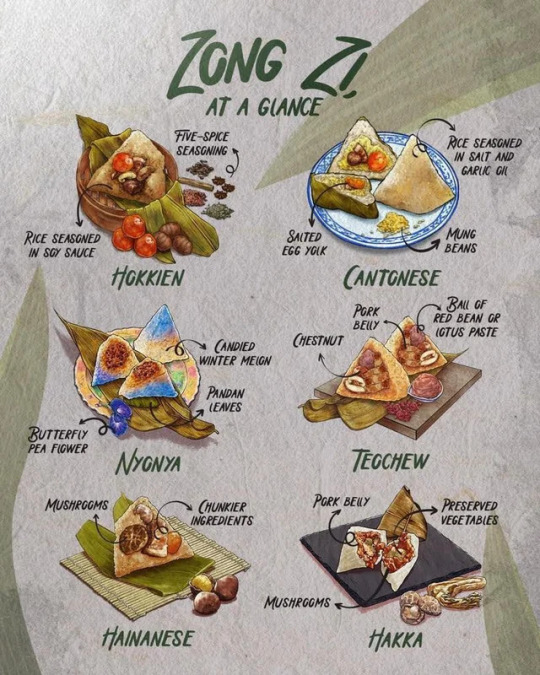
youtube
Hokkien Rice Dumpling (福建咸肉粽) - One of the most common Zong Zi that can be found in markets and stores, the Hokkien Zong Zi is wrapped in bamboo leaves is recognized by its dark appearance from soy sauce infused rice and distinct aroma from the five-spice seasoning. Usually made with pork belly, salted egg yolk, chestnuts and dried shrimps.

Cantonese Rice Dumpling (广东咸肉粽) - The ingredient that sets Cantonese Zong Zi apart is the filling of mung beans or green beans. One can also order a variation with a salted egg yolk. The glutinous rice is also seasoned with salt and garlic oil instead of soy sauce.

Nyonya Rice Dumpling (娘惹粽) - The Nyonya Zong Zi is the most distinguishable rice dumpling for its bright blue tip that is typically made from the extract of the butterfly pea flower. It is also sweeter in taste and aroma because of its pandan leaf wrapper and candied winter melon.

Teochew Rice Dumpling (潮州粽) - The savoury yet sweet taste of a Teochew Zong Zi comes from various ingredients such as red bean paste or lotus paste, fatty pork belly, earthy mushrooms and dried shrimp. Chestnuts are also added to the dumpling for texture.
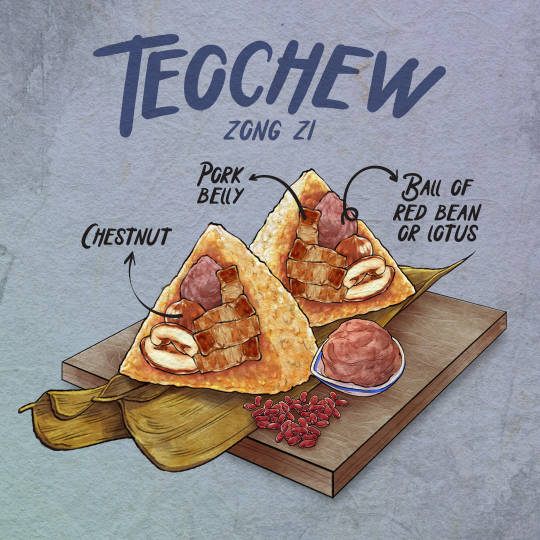
Hainanese Rice Dumpling (海南肉粽) - The Hainanese Zong Zi’s most distinctive trait lies in its portion. It is filled with generous chunks of pork belly, whole chestnuts, mushrooms, and seasonings of savoury additions like five-spice powder, dark soy sauce, and black pepper. It is also usually served with a dollop of palm sugar syrup, adding a nice balance of sweetness to its savoury and slightly spicy flavour.
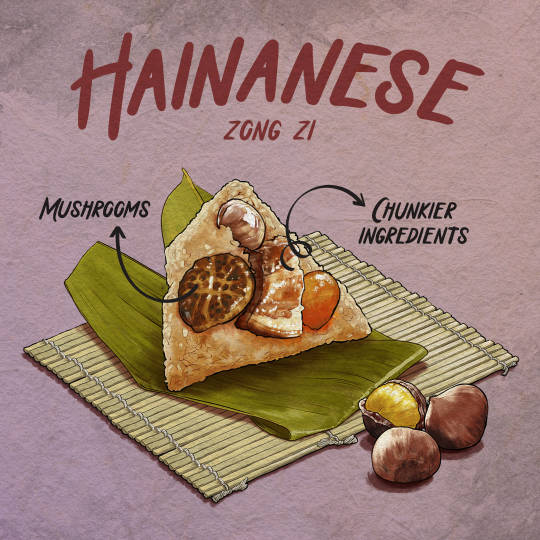
Hakka Rice Dumpling (客家粽) - Steamed in bamboo leaves, the Hakka Zong Zi consists of preserved vegetable filling, juicy pork belly strips and savoury mushrooms. It is also sometimes filled with beans.
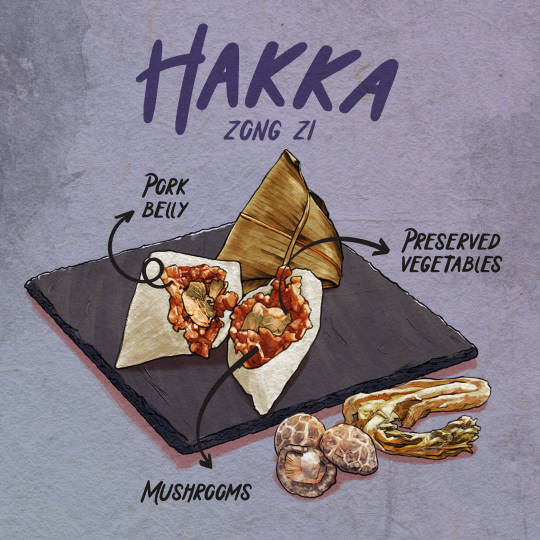
Zong Zi info from here and images from Ministry of Culture, Community and Youth.
#Dragon Boat Festival#端午节#农历五月初五#Rice Dumpling#粽子#Zong Zi#Hokkien Rice Dumpling#福建咸肉粽#Cantonese Rice Dumpling#广东咸肉粽#Nyonya Rice Dumpling#娘惹粽#Teochew Rice Dumpling#潮州粽#Hainanese Rice Dumpling#海南肉粽#Hakka Rice Dumpling#客家粽#Video#Youtube#Asian Food#Food#Buffetlicious
110 notes
·
View notes
Text

2024.06.10 - Dragon Boat Festival promo photo for A Dream Within a Dream, starring Liu Yuning and Li Yitong (Weibo source)
24 notes
·
View notes
Text
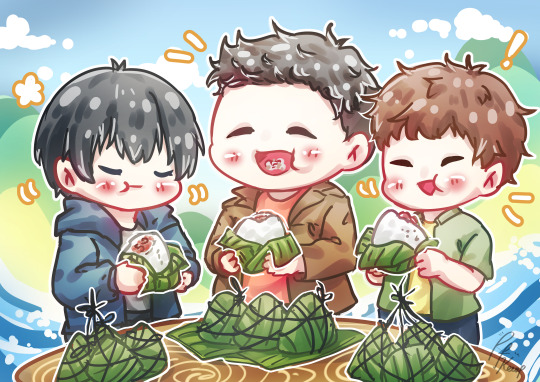
端午节安康! Wishing you good health during the Dragon Boat Festival 🐲🚣♂️
Iron Triangle eating Zongzi together 🥰❤️✨
#端午节#Dragon Boat Festival#盗墓笔记#dmbj#铁三角#吴邪#张起灵#王胖子#daomu biji#zhang qiling#wu xie#wang pangzi#iron triangle#chinese novel#fanart#digital illustration
77 notes
·
View notes
Text




Getting ready for Dragon Boat Festival! Made a batch of Zongzi/Joong 粽子 (Chinese sticky rice dumplings) Recipe
#zongzi#joong#chinese sticky rice dumplings#glutinous rice dumplings#dragon boat festival#粽子#recipes#chinese recipes#chinese food#端午节#chinese cuisine#chinese culture#bamboo leaves#sticky rice dumplings#sticky rice#food blog#sikfan kitchen#food#asian food
8 notes
·
View notes
Text







The Chinese consulate invited some Confucius Institute students for an event in celebration of the Dragon Boat festival yesterday.
It was pretty cool, a lot more fun than I expected. There was a video about the Dragon Boat festival, a zongzi workshop ("and now you take your zongzi home and cook it for about 3 hours"), papercutting, calligraphy and painting with Q-tips workshops (the calligraphy one was always full) and a few singing and dancing presentations (I sang the first 2 minutes of 《美丽世界的孤儿》).
There were also some Chinese snacks, and we did get to try some zongzi! I found it tasty, and quite filling.
We also got a goddie bag with a panda keychain, a moleskin-type notebook and a book of "stories of friendship between China and Brazil".
It was a very cool experience overall.
45 notes
·
View notes
Text

source
#guo zong#粿棕#zong zi#棕子#food#dragon boat festival#duanwu#端午节#龙船节#savory zong zi#chinese food#east asian food#asian food#xiao hong shu#小红书
4 notes
·
View notes
Text
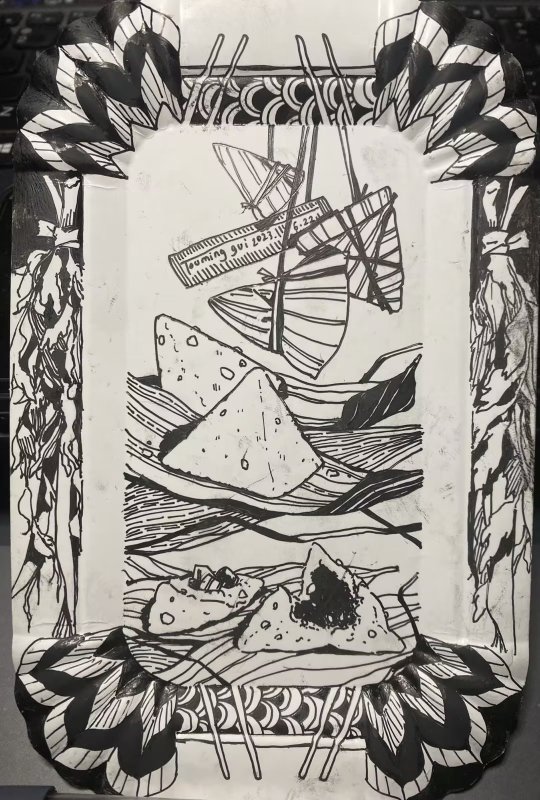
端午节快乐!
#端午节#dragon boat festival#端午節#端午の節句#粽子#rice dumpling#ちまき#painting#art#paint#drawing#artists on tumblr#illustration#绘画#draw#絵
3 notes
·
View notes
Text
Happy Duanwu to all my pengyous out there!
3 notes
·
View notes
Text






Spend Dragon Boat Festival/Duanwu Festival on Aobi Island 🐻
One of my favorite festivals because: I get to eat delicious Zongzi/rice dumplings and enjoy holiday with my family.
Of course, also with my bear buddies!
0 notes
Photo
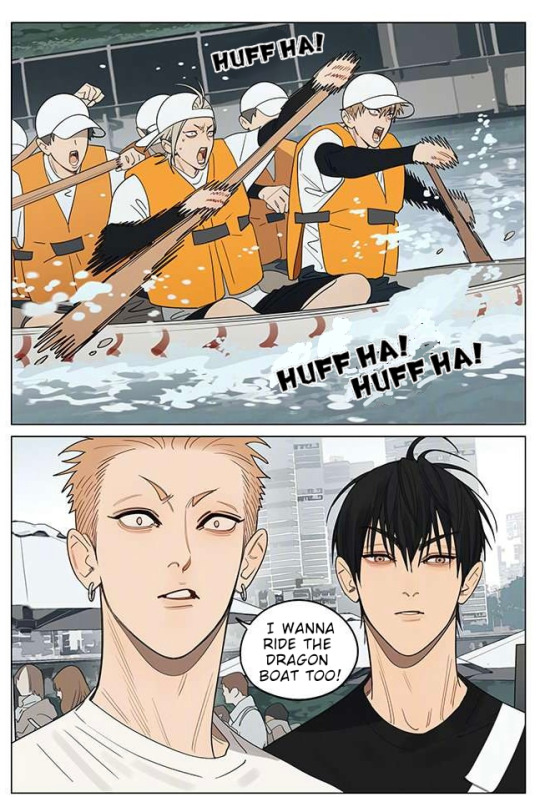
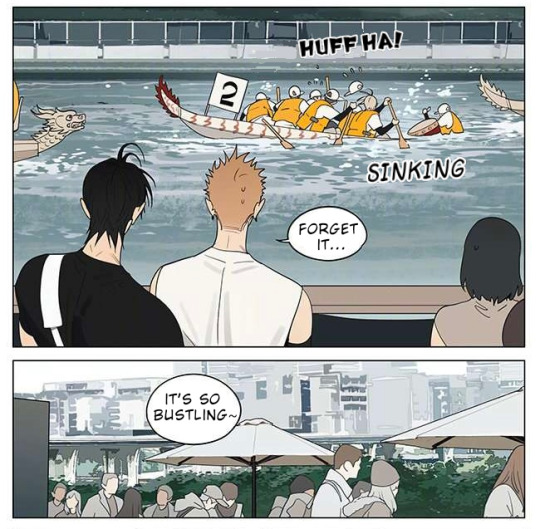
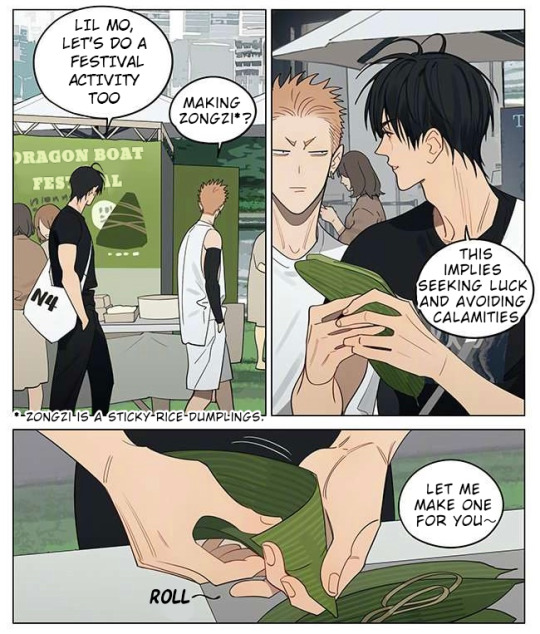
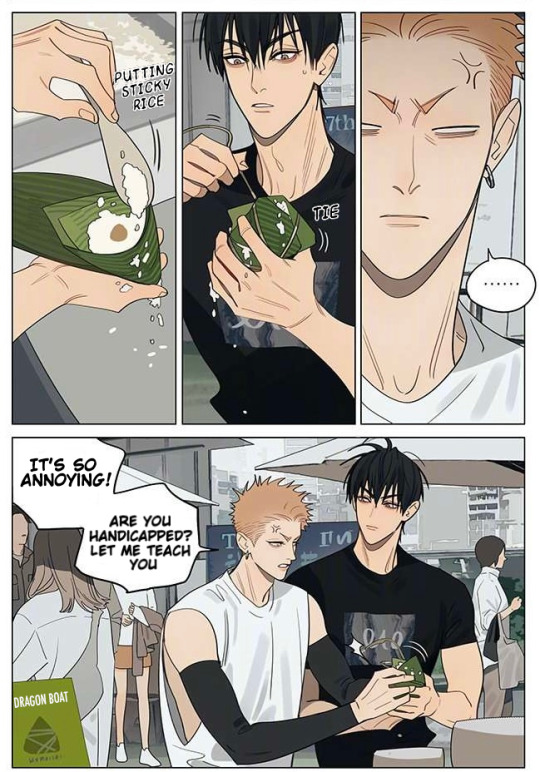



old xian’s new update
#19天# 端午节特别篇。 #19days# (Special chapter on Dragon Boat Festival)
#19 days#old xian#old xian 19 days#english translation#19days translation#he tian#mo guan shan#tianshan#jan yi#zhan zheng xi
3K notes
·
View notes
Text
The Dragon Boat Festival or Duan Wu Jie (端午节), is also known as Duan Yang Jie (端阳节), which means “Upright Sun” or “Double Fifth” (重午/重五). Falling on the fifth day of the fifth lunar month around the summer solstice which happened to be 10th June 2024 this year. The festival is also commonly referred to as the Fifth Month Festival amongst the Chinese. Its origins can be traced to southern China, and festivities include boat races and eating rice dumplings. The festival had evolved from the practice of revering the river dragon, to the commemoration of Qu Yuan (屈原), a third-century poet and political figure of the state of Chu in ancient China.

Legends and Myths - River Dragon (蛟龙)
The dragon was initially viewed as the benevolent spirit of the waters. It exemplified the masculine principle or yang in the Chinese ideology of harmony. Among common folk, it was believed that the River Dragon (蛟龙) controlled the rain and was thus worshipped during the summer solstice. Requests would be made for a balanced rainfall – sufficient to ensure a good harvest, without over-abundance that would cause destructive flooding.

Legends and Myths - Qu Yuan (屈原)
Primitive worship of the river dragon was often practised during the summer solstice. The Dragon Boat Festival was associated with Qu Yuan’s story only in the second century. Qu Yuan (屈原) was a poet and a statesman for the Chu kingdom (楚国) during the Warring States Period (战国时代). He served in high office and he advocated a policy of aligning with other kingdoms against the dominant Qin. However, political intrigue led Lord Huai to banish Qu Yuan instead. The ministry was left in the hands of corrupt statesmen and Qu Yuan helplessly watched his motherland decline. Depressed, he penned beautiful, patriotic poetry such as Li Sao (离骚) which means Encountering Sorrow, an allegorical poem stating his political aspirations and Jiu Ge (九歌) or Nine Songs, which gained Qu Yuan great renown.
youtube
With his top adviser gone, the king fell for the trickery of the Qin and his kingdom was eventually conquered. Upon hearing that his kingdom’s capital had been overtaken by the Qin, Qu Yuan committed suicide by drowning himself in the Mi Luo River (汨罗江). As he was adored by people everywhere, the local people did everything in their power to try to either save Qu Yuan, or at the very least, to protect him in the afterlife.

Hereupon the legend varies. Some suggest that fishermen at the scene attempted to save their minister. Having failed, they sought to appease his spirit by throwing rice stuffed in bamboo stems into the river to prevent the fish from eating Qu Yuan’s body. Others say that the rice offerings were snatched by a river dragon and the rice had to be bundled in chinaberry leaves instead and tied with five different coloured silk threads in order to be effective. The triangular Rice Dumplings (粽子) thus became entwined with the festivities. Another version tells of farmers rowing out in dragon boats in their attempt to save Qu Yuan. Hence, Dragon Boat Racing (赛龙舟) has been held annually on the fifth day of the fifth lunar month, in honour of the memory of Qu Yuan.

Or if reading through a wall of texts is not your cup of tea, here is a pictorial guide to summarize on the history of Qu Yuan (屈原) and how we ended up celebrating Dragon Boat Festival (端午节) with dragon boat racing and rice dumplings on the fifth day of the fifth lunar month.

All images are from the internet. Selected text info from here.
#Dragon Boat Festival#端午节#农历五月初五#Qu Yuan#屈原#Rice Dumpling#粽子#Bamboo Leaf#Dragon Boat Racing#赛龙舟#Festival#Tradition#Chinese Culture#Video#Youtube#Food#Buffetlicious
46 notes
·
View notes
Text

My friend/coworker gave me a red bean zongzi! Happy dragon boat festival!!
1 note
·
View note
Text

*・゜゚・*:.。端午节快乐o(^▽^)o。.:*・゜゚・*
Happy Dragon Boat Festival o(^▽^)o
#year: 2024#dragon boat festival#a gen#xiaobai#xiaohei#shanxin#lxh#羅小黒戦記#罗小黑战记#luo xiao hei zhan ji#the legend of luoxiaohei
104 notes
·
View notes
